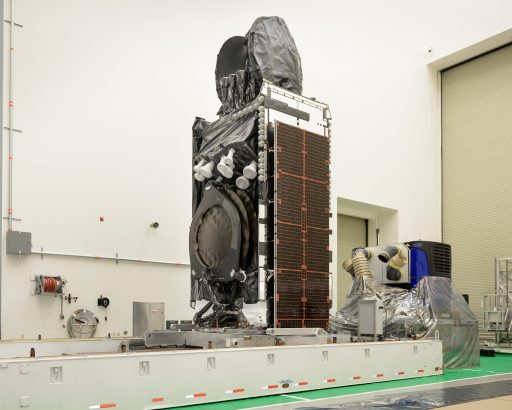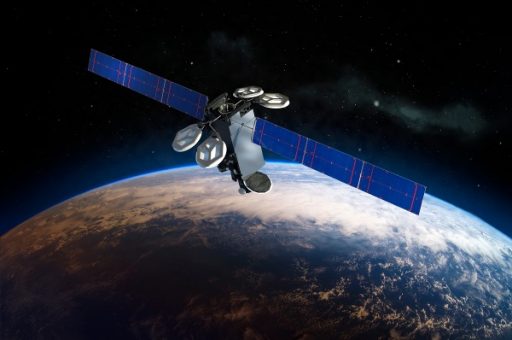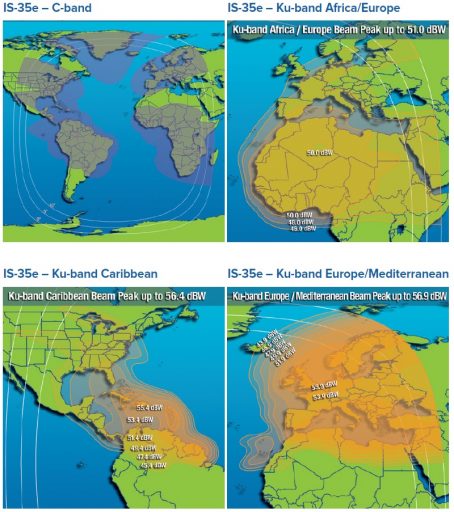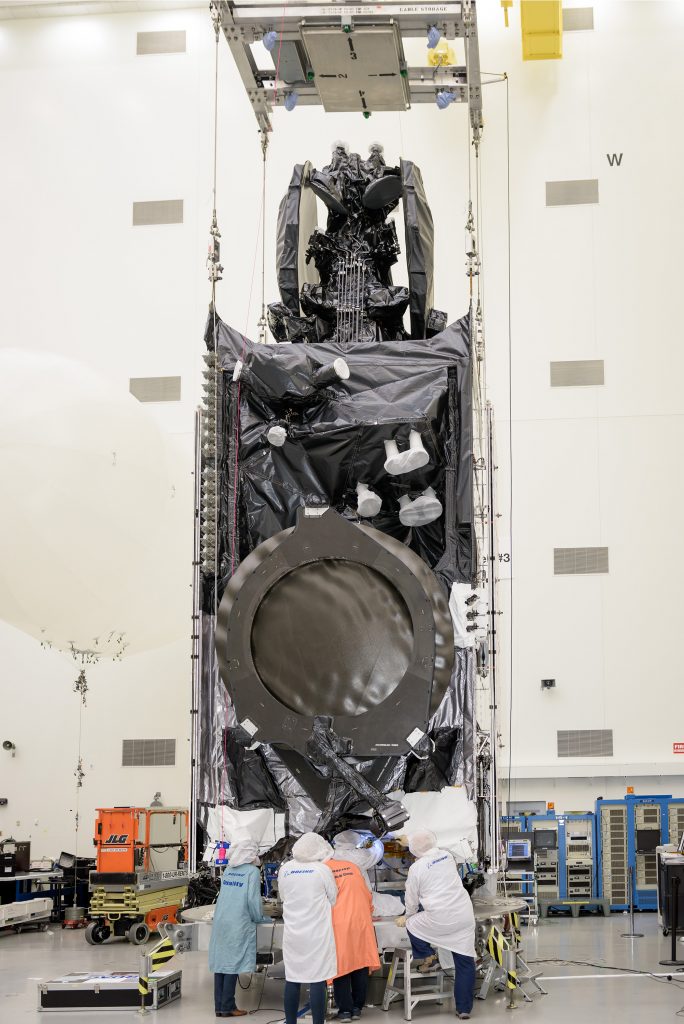Intelsat 35e

Intelsat 35e is a commercial communications satellite built by Boeing Space Systems for operation by Luxembourg-based global telecommunications provider Intelsat as the fourth in the company’s Epic-NG satellite series designed to provide flexible communications services. The Epic architecture delivers global high-throughput services utilizing the C-, Ku- and Ka-Bands, a combination of wide beams and spot beams as well as frequency reuse to provide a high degree of flexibility to customers.
The Intelsat 35e satellite combines a high-throughput Ku-Band and C-Band package to deliver high-performance services through a combination of C-Band wide and spotbeams and large Ku-Band coverage zones. The combination of high-capacity spot and wide beam coverage enables improved throughput for data-intensive services like wireless backhaul, enterprise and mobility services in areas where weather patterns necessitate the use of the more robust C-Band spectrum. The Ku-Band payload delivers a customized high-power wide beam for Direct-to-Home Television distribution in the Caribbean, and services for mobility and government applications in Europe, the Caribbean, and Africa.

The C-Band payload on Intelsat 35e has a combined bandwidth of 4,465 MHz, hosting 124 transponders (36 MHz equivalent units) that deliver a total of 17 coverage areas. Covered by the C-Band package is almost the entire European continent with the exception of the extreme northern and southern regions; C-Band coverage over Africa is provided to all sub-Saharan countries and in coastal areas; a northern beam covers Greenland; dedicated beams deliver Coverage to portions of North America and the entire Caribbean Sea; and South America is covered in its entirety with the exception of Argentina, Southern Chile and Uruguay.
Intelsat 35e hosts 39 (36 MHZ equivalent) Ku-Band transponders with a bandwidth of 1,404 MHz, delivering three distinct coverage zones that carry services to the entire European Continent and Northern Africa, Western Africa and the Sahara countries, and the Caribbean. The Ku package operates at frequencies of 10.95-11.20 and 11.45-11.70 GHz for downlink and 13.75 to 14.50 GHz for uplink.

Intelsat’s Epic technology implements frequency re-use which refers to a satellite using the same frequency multiple times resulting in a significant increase in the efficiency of spectrum utilization and boosting the total bandwidth that a spectral band can deliver.
Interference is avoided by combining different frequencies and polarizations, allowing frequency reuse over the same geographic area. Intelsat expanded frequency re-use from the traditional Ka-Band high-throughput application to the C- and Ku-Band spectrum which can be combined with traditional wide and spot beams for high-throughput and broadcasting services from a single satellite. Intelsat 35e uses Epic technology for its C-Band payload only.
Intelsat signed with Boeing in 2009 to be the first customer for the 702MP medium-power version of Boeing’s flagship satellite bus, ordering four satellites (21, 22, 27 and Intelsat 29e as the first Epic satellite). An additional order was placed in 2013 for another four 702MP-based Epic satellites and a ninth 702MP (the sixth Epic) craft, Intelsat 35e, was ordered in May 2014.
After ordering the Intelsat 35e satellite, Intelsat announced initial services for customers would begin using the Intelsat-903 craft, launched in 2002 and residing at 34.5 degrees West. Services will seamlessly transition to Intelsat 35e as the 903 satellite enters decommissioning after its planned 15-year service life. Intelsat 35e is launched fairly close to its initial expectation of a 1st quarter liftoff in 2017 despite significant delays suffered by SpaceX.

Intelsat 35e is based on Boeing’s BSS-702 MP configuration that minimizes the larger 702HP satellite bus, suitable for communications payloads requiring 6 to 12kW of power. According to Boeing, the 702MP “features the same high-performance capabilities as the Boeing 702HP (high power) model, but with a substantially updated satellite bus structure and simplified propulsion system.”
Built for a 15-year service life, Intelsat 35e has a launch mass of 6,761 Kilograms, taking Falcon 9 beyond its first stage recovery capability and requiring a fully expendable launcher.
Electrical power is generated by two deployable solar arrays and stored in Li-Ion batteries with dedicated avionics conditioning the satellite power bus that supplies electrical power to the various bus systems, the electric propulsion system and the satellite payload. Power is stored in dual Lithium-Ion batteries and dedicated avionics regulate the main power bus of the spacecraft to provide power to all subsystems of the satellite bus and the communications payload.
The satellites use a state of the art attitude determination and control system utilizing star trackers and Earth sensors for precise attitude determination and reaction wheels for accurate pointing.
The satellite bus is typically equipped with a 490-Newton bipropellant apogee motor for the climb into Geostationary Orbit. In addition, the satellite uses four axial 22-Newton Thrusters and four radial 10-Newton thrusters for smaller orbit adjustments, drifting in Geostationary Orbit and attitude maneuvers. BSS-702 can also support electrical propulsion systems based on Boeing’s XIPS ion thrusters.
